What Needs to be in a Seller’s Property Disclosure Statement?

With the sale of every home, the seller has to provide the buyer with many different documents before the sale can go through. One of the most important is called the seller’s property disclosure statement. This form is meant to inform the buyer of any defects that can hurt the property’s perceived value and safety.
The seller must produce it and should do so with the help of an inspector and a lawyer. The buyer should request it and look over it before taking the final steps of acquiring the property. Whether the property is meant for commercial or residential purposes, a disclosure agreement is still required.
On the other hand, as the name implies, this is an agreement with sellers. This means there is no seller’s property disclosure agreement between lessors and lessees.
What Should be in a Seller’s Property Disclosure Statement?
Disclosure statements usually contain facts regarding potential damages to the property or features the property lacks. Some of the elements that you need to disclose contain:
- Seller’s knowledge in areas related to the construction and condition of the property and any improvements. Any recent construction that has been recommended, started, or completed needs to be in the document.
- The date the property was last occupied. Particularly when it was operating to its full capacity as a home or a business. The realtor walking people through the house/building for an open house is not the same as being occupied.
- The condition of the roof. If there is observable damage to the roof from something like a storm or a fallen tree, for example.
- If there is a basement and/or crawl space. The owners need to know if they are prone to flooding, and if these spaces are accessible from the outside and/or inside.
- If there are termites in the house or have ever had termites. They can cause or leave behind structural damage to key parts of the house/building that buyers need to be aware of before the sale goes through.
- If there are any structural issues. Whether it be from termites, mold, storms, or age, anything resembling an issue to the structure of the property needs to be noted.
- Additions and remodels need to be noted. The disclosure statement must contain which parts of the property have been added and changed since the house was first built.
- The state of the property’s water, sewage, and plumbing. The age and state of the property’s piping should be documented for the buyer.
- Whether there is heating or air conditioning. No property needs to have air conditioning but they are required to have heating in Pennsylvania. Air conditioning may be necessary to a property for a commercial purpose.
- Who the electricity provider is. The buyer needs to know who provides them with their electricity.
- The state of the soil and water drainage of the property. The buyer needs to know the quality of the property’s current soil and how soon they might need to replace it.
- If there are any hazardous substances on the premises. Waste, natural gas, and mold are things that buyers need to be notified about in the disclosure agreement.
- If there are any homeowners associations in the neighborhood that the new buyer needs to be aware of. A homeowners association has rules and regulations that they place on whoever owns a home under their association. The buyer needs to know what rules they need to abide by before moving in.
- Any legal issues on the property or title. If there are any liens on the property, the new buyers need to know because they will incur them.
There’s a lot that should be mentioned in your property disclosure statement, even if it’s to say there is no problem. Go over with the house inspector what needs to be noted and talk to a real estate attorney on how it should be said.
Contact Mazzoni Valvano Szewczyk & Karam for Your Seller’s Property Disclosure Statement
Whether you’re a buyer or a seller, you want to have a disclosure statement one way or another. Buyers need to have peace of mind in their purchase and to understand the intricacies of the property they are purchasing. A seller needs written proof that they disclosed any and all the information a buyer needs to know. This can be legal protection if a buyer later claims to have been unaware of anything you detailed in your disclosure statement.
So, if you need help checking the finer details of a seller’s property disclosure agreement, or assistance with creating your own, contact Mazzoni Valvano Szewczyk & Karam. Our Scranton real estate attorneys can help.

